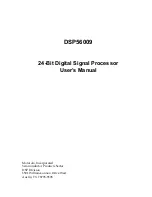Summary of Contents for DSP56009
Page 19: ...MOTOROLA DSP56009 User s Manual 1 1 SECTION 1 OVERVIEW ...
Page 38: ...1 20 DSP56009 User s Manual MOTOROLA Overview DSP56009 Architectural Overview ...
Page 39: ...MOTOROLA DSP56009 User s Manual 2 1 SECTION 2 SIGNAL DESCRIPTIONS ...
Page 64: ...2 26 DSP56009 User s Manual MOTOROLA Signal Descriptions On Chip Emulation OnCETM Port ...
Page 65: ...SECTION 3 MEMORY OPERATING MODES AND INTERRUPTS ...
Page 85: ...MOTOROLA DSP56009 User s Manual 4 1 SECTION 4 EXTERNAL MEMORY INTERFACE ...
Page 149: ...MOTOROLA DSP56009 User s Manual 5 1 SECTION 5 SERIAL HOST INTERFACE ...
Page 180: ...5 32 DSP56009 User s Manual MOTOROLA Serial Host Interface SHI Programming Considerations ...
Page 181: ...MOTOROLA DSP56009 User s Manual 6 1 SECTION 6 SERIAL AUDIO INTERFACE ...
Page 207: ...MOTOROLA DSP56009 User s Manual 7 1 SECTION 7 GENERAL PURPOSE INPUT OUTPUT ...
Page 212: ...7 6 DSP56009 User s Manual MOTOROLA General Purpose Input Output GPIO Register GPIOR ...
Page 220: ...A 8 DSP56009 User s Manual MOTOROLA Bootstrap ROM Contents ...
Page 221: ...MOTOROLA DSP56009 User s Manual B 1 APPENDIX B PROGRAMMING REFERENCE ...
Page 250: ...B 30 DSP56009 User s Manual MOTOROLA Programming Reference ...
Page 251: ...MOTOROLA DSP56009 User s Manual C 1 APPENDIX C APPLICATION EXAMPLES ...
Page 262: ...C 12 DSP56009 User s Manual MOTOROLA Application Examples ...
Page 269: ...MOTOROLA DSP56009 User s Manual C 1 APPENDIX C APPLICATION EXAMPLES ...
Page 280: ...C 12 DSP56009 User s Manual MOTOROLA Application Examples ...



































